How can it record and process audio without access to storage?I downloaded the beta and was about to test it out, but the permissions request surprised me.
The app asked for complete access to the phone's storage, and the small print indicated that, if permission were granted, the aop could ask storage without notifying the user.
Is all of that necessary, just to allow the app to record audio?
You are using an out of date browser. It may not display this or other websites correctly.
You should upgrade or use an alternative browser.
You should upgrade or use an alternative browser.
Beta Test: Room Correction for Android
- Thread starter WiiM Team
- Start date
In my opinion, as far as using the built-in microphone, it could depend on the phone model.Wiim does correctly identify the issues my room has at 40hz and 120hz as identified by my vastly more sophisticated Anthem system, and corrects them pretty well.
My three phones showed different results.
This shows how the bass frequency response changed before and after the RC run.
Before RC (NO EQ)
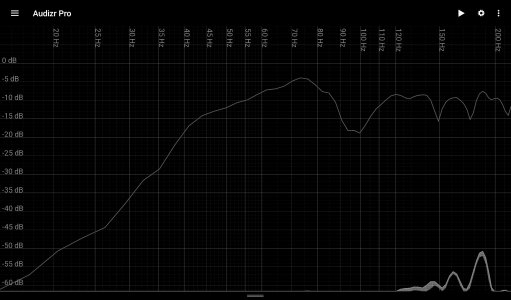
1. LG V60 (Harman RC)
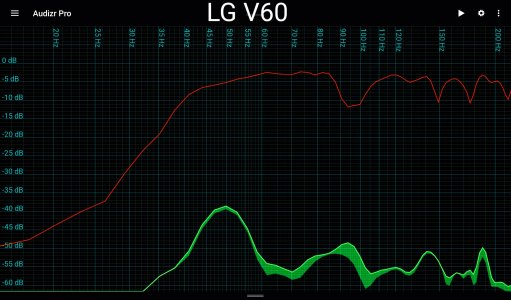
2. Xiaomi 12T pro (Harman RC)
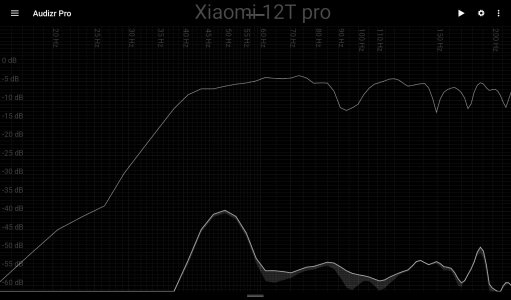
3. Xiaomi 13T pro (Harman RC)
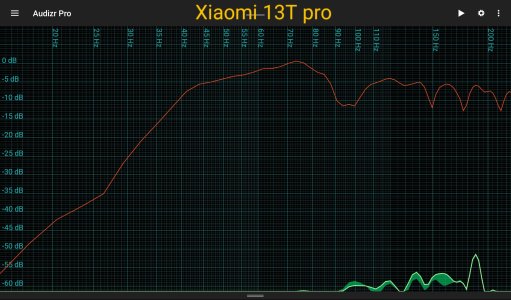
The results for the V60 and 12T are very similar, flattening out the
Also, it was uncomfortable on my speakers as it (excessively) rises along the Harman curve down to 45hz.
Finally, this is the result of my manual adjustment in WiiM PEQ. (Sub is included.)
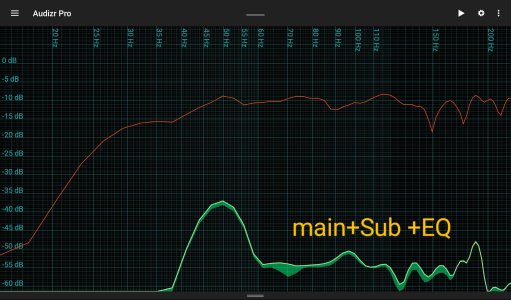
Last edited:
No, I have asked them about IMM-6C and have not yet received an answer. (I mean, all four tickets are unanswered.Has anyone received an acknowledgement of any tickets submitted yet?
However, they did respond to my other ticket regarding Spotify rate display, so support is working.
They may have hit brick wall at the moment. They are researching how to get rc similar result from iOS since there are variation of mic on each android phone. Unlike Apple, everything is by their own specs. As a consumer, we’re all demanding on everything but that kind of work they do is difficult.No, I have asked them about IMM-6C and have not yet received an answer. (I mean, all four tickets are unanswered.)
However, they did respond to my other ticket regarding Spotify rate display, so support is working.
Maybe so, but given that some external mics are already supported, I think we will soon have the same results as iOS.They may have hit brick wall at the moment. They are researching how to get rc similar result from iOS since there are variation of mic on each android phone. Unlike Apple, everything is by their own specs. As a consumer, we’re all demanding on everything but that kind of work they do is difficult.
I
(I had the ipad mini 1st gen a long time ago.)
Last edited:
Clearly that's the case, which is why Wiim explicitly recommends using an external mic. I highly doubt that will change even as the beta is updated.In my opinion, as far as using the built-in microphone, it could depend on the phone model.
My three phones showed different results.
This shows how the bass frequency response changed before and after the RC run.
slartibartfast
Major Contributor
- Joined
- Apr 18, 2024
- Messages
- 1,190
Where did you get Audizr Pro from? It isn't in the Google Play StoreIn my opinion, as far as using the built-in microphone, it could depend on the phone model.
My three phones showed different results.
This shows how the bass frequency response changed before and after the RC run.
Before RC (NO EQ)
View attachment 9409
1. LG V60 (Harman RC)
View attachment 9410
2. Xiaomi 12T pro (Harman RC)
View attachment 9411
3. Xiaomi 13T pro (Harman RC)
View attachment 9412
The results for the V60 and 12T are very similar, flattening out the75 dB75Hz hump. The 13T, however, does not. The 13T has a MediaTek SoC while the other two are Snapdragon. Perhaps this could be a factor, but I don't know.
Also, it was uncomfortable on my speakers as it (excessively) rises along the Harman curve down to 45hz.
Finally, this is the result of my manual adjustment in WiiM PEQ. (Sub is included.)
View attachment 9413
Unfortunately, this APP has already been discontinued.Where did you get Audizr Pro from? It isn't in the Google Play Store
Here's an update: it does correctly use my external mic which is an iMM-6 connected via an unbranded USB-C jack adapter (the adapter came with my previous pixel 7 along with a jack headset).
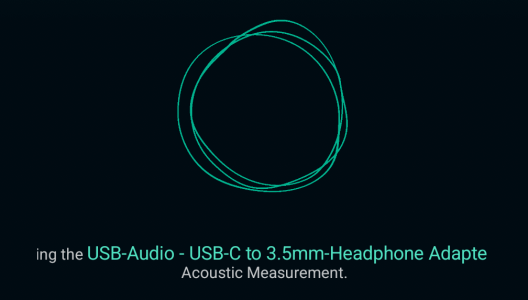
Ah, after plugging it into the laptop, I checked and it's actually the Google adapter:
So that at least seems to work fine and the measurements look roughly in line with the sam iMM-6 plugged into the jack of an old'ish iPad
However one bug I found is that the max gain is ignored (either that or doesn't properly handle negative gains). I set it to 5dB and I get this:
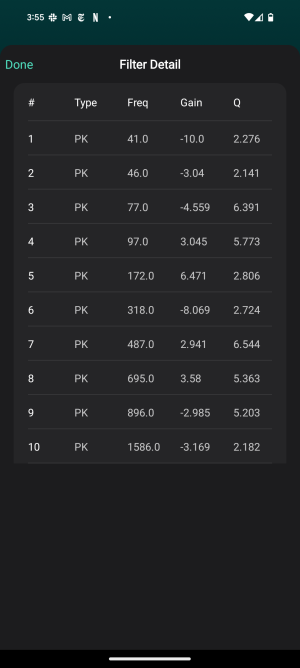

Ah, after plugging it into the laptop, I checked and it's actually the Google adapter:
Code:
[681774.573242] usb 1-1: new full-speed USB device number 25 using xhci_hcd
[681774.771975] usb 1-1: New USB device found, idVendor=18d1, idProduct=5025, bcdDevice=23.20
[681774.771998] usb 1-1: New USB device strings: Mfr=3, Product=1, SerialNumber=2
[681774.772005] usb 1-1: Product: USB-C to 3.5mm-Headphone Adapter
[681774.772012] usb 1-1: Manufacturer: Google
[681774.772017] usb 1-1: SerialNumber: FLK71002052020A79F06C19
[681775.561756] input: Google USB-C to 3.5mm-Headphone Adapter as /devices/pci0000:00/0000:00:14.0/usb1/1-1/1-1:1.3/0003:18D1:5025.0021/input/input54
[681775.622363] hid-generic 0003:18D1:5025.0021: input,hidraw10: USB HID v1.11 Device [Google USB-C to 3.5mm-Headphone Adapter] on usb-0000:00:14.0-1/input3So that at least seems to work fine and the measurements look roughly in line with the sam iMM-6 plugged into the jack of an old'ish iPad
However one bug I found is that the max gain is ignored (either that or doesn't properly handle negative gains). I set it to 5dB and I get this:

I will try to see if my conversion adapter can do that. Is the 3.5mm jack on the adapter 4-pole (TRRS)?Here's an update: it does correctly use my external mic which is an iMM-6 connected via an unbranded USB-C jack adapter (the adapter came with my previous pixel 7 along with a jack headset).
View attachment 9415
Ah, after plugging it into the laptop, I checked and it's actually the Google adapter:
Code:[681774.573242] usb 1-1: new full-speed USB device number 25 using xhci_hcd [681774.771975] usb 1-1: New USB device found, idVendor=18d1, idProduct=5025, bcdDevice=23.20 [681774.771998] usb 1-1: New USB device strings: Mfr=3, Product=1, SerialNumber=2 [681774.772005] usb 1-1: Product: USB-C to 3.5mm-Headphone Adapter [681774.772012] usb 1-1: Manufacturer: Google [681774.772017] usb 1-1: SerialNumber: FLK71002052020A79F06C19 [681775.561756] input: Google USB-C to 3.5mm-Headphone Adapter as /devices/pci0000:00/0000:00:14.0/usb1/1-1/1-1:1.3/0003:18D1:5025.0021/input/input54 [681775.622363] hid-generic 0003:18D1:5025.0021: input,hidraw10: USB HID v1.11 Device [Google USB-C to 3.5mm-Headphone Adapter] on usb-0000:00:14.0-1/input3
So that at least seems to work fine and the measurements look roughly in line with the sam iMM-6 plugged into the jack of an old'ish iPad
However one bug I found is that the max gain is ignored (either that or doesn't properly handle negative gains). I set it to 5dB and I get this:
View attachment 9416
Thanks.
slartibartfast
Major Contributor
- Joined
- Apr 18, 2024
- Messages
- 1,190
The Pixel 3a and 6a only came with a USB A to USB C adaptor. Connecting the iMM6 via a 3.5mm jack to USB A adaptor then adding the USB A to C adaptor doesn't work for me unfortunately.Here's an update: it does correctly use my external mic which is an iMM-6 connected via an unbranded USB-C jack adapter (the adapter came with my previous pixel 7 along with a jack headset).
View attachment 9415
Ah, after plugging it into the laptop, I checked and it's actually the Google adapter:
Code:[681774.573242] usb 1-1: new full-speed USB device number 25 using xhci_hcd [681774.771975] usb 1-1: New USB device found, idVendor=18d1, idProduct=5025, bcdDevice=23.20 [681774.771998] usb 1-1: New USB device strings: Mfr=3, Product=1, SerialNumber=2 [681774.772005] usb 1-1: Product: USB-C to 3.5mm-Headphone Adapter [681774.772012] usb 1-1: Manufacturer: Google [681774.772017] usb 1-1: SerialNumber: FLK71002052020A79F06C19 [681775.561756] input: Google USB-C to 3.5mm-Headphone Adapter as /devices/pci0000:00/0000:00:14.0/usb1/1-1/1-1:1.3/0003:18D1:5025.0021/input/input54 [681775.622363] hid-generic 0003:18D1:5025.0021: input,hidraw10: USB HID v1.11 Device [Google USB-C to 3.5mm-Headphone Adapter] on usb-0000:00:14.0-1/input3
So that at least seems to work fine and the measurements look roughly in line with the sam iMM-6 plugged into the jack of an old'ish iPad
However one bug I found is that the max gain is ignored (either that or doesn't properly handle negative gains). I set it to 5dB and I get this:
View attachment 9416
I suppose it is, it came with a headset bundled with the phone which has a mic (and it has been working fine for RC)I will try to see if my conversion adapter can do that. Is the 3.5mm jack on the adapter 4-pole (TRRS)?
Thanks.
Mine is, I think, the adapter Google sells (or used to) under their own brand.The Pixel 3a and 6a only came with a USB A to USB C adaptor. Connecting the iMM6 via a 3.5mm jack to USB A adaptor then adding the USB A to C adaptor doesn't work for me unfortunately.
When I bought the 7, it came with a box for that adaptor and a box for a 3rd party headset all taped together. I remember someone making a comment that they couldn't sell a phone without headset back then (it was a local telco Telstra bundle).
It doesn't appear to exist on the online google store anymore but is still listed by a couple of local online stores in Australia.
slartibartfast
Major Contributor
- Joined
- Apr 18, 2024
- Messages
- 1,190
I am still waiting for the WiiM app to recognise the iMM6 plugged into the 3.5mm jack. Other software can do it automatically. WiiM is the only software I have found that doesn't detect itMine is, I think, the adapter Google sells (or used to) under their own brand.
When I bought the 7, it came with a box for that adaptor and a box for a 3rd party headset all taped together. I remember someone making a comment that they couldn't sell a phone without headset back then (it was a local telco Telstra bundle).
It doesn't appear to exist on the online google store anymore but is still listed by a couple of local online stores in Australia.
Yes, it's recognized and works in other apps.Does your phone recognize the USB mic in other apps?
Agreed. We should not forget, though, that WiiM RC will be applied by users with little to no experience with RC and Auto EQ.Of course it's on WiiM to some extent to establish reasonable expectations. But anyone with any experience with RC and Auto EQ knows that systems that do full range EQ involve multi point measurements , individual speaker measurements and repeated sweeps. This is not that. Wiim does correctly identify the issues my room has at 40hz and 120hz as identified by my vastly more sophisticated Anthem system, and corrects them pretty well. That meets my personal expectations for a beta release.
Interestingly, my own manual correction based on multi point measurements in REW and the WiiM Auto EQ filters (using the same UMIK-1) are quite a bit different, but both very listenable. I don't really have a sweet spot for listening to this secondary system, so overall I like my own correction better.
Same here.However one bug I found is that the max gain is ignored (either that or doesn't properly handle negative gains). I set it to 5dB and I get this:
I also like the new design of the EQ/PEQ page better, where it looks more like regular tabs now.
Last edited:
slartibartfast
Major Contributor
- Joined
- Apr 18, 2024
- Messages
- 1,190
Have you tried the moving mic method with REW? It uses the RTA and pink noise to produce an average response over your chosen area.Agreed. We should not forget, thought, that WiiM RC will be applied by users with little to no experience with RC and Auto EQ.
Interestingly, my own manual correction based on multi point measurements in REW and the WiiM Auto EQ filters (using the same UMIK-1) are quite a bit different, but both very listenable. I don't really have a sweet spot for listening to this secondary system, so overall I like my own correction better.
Same here.
I also like the new design of the EQ/PEQ page better, where it looks more like regular tabs now.
No, I did multiple measurements across the entire room plus "theoretical" MLP instead and weighted them differently according to my own ... err ... wisdom.Have you tried the moving mic method with REW? It uses the RTA and pink noise to produce an average response over your chosen area.
Similar threads
- Replies
- 40
- Views
- 2K
- Replies
- 31
- Views
- 3K
- Locked
- Replies
- 854
- Views
- 58K

